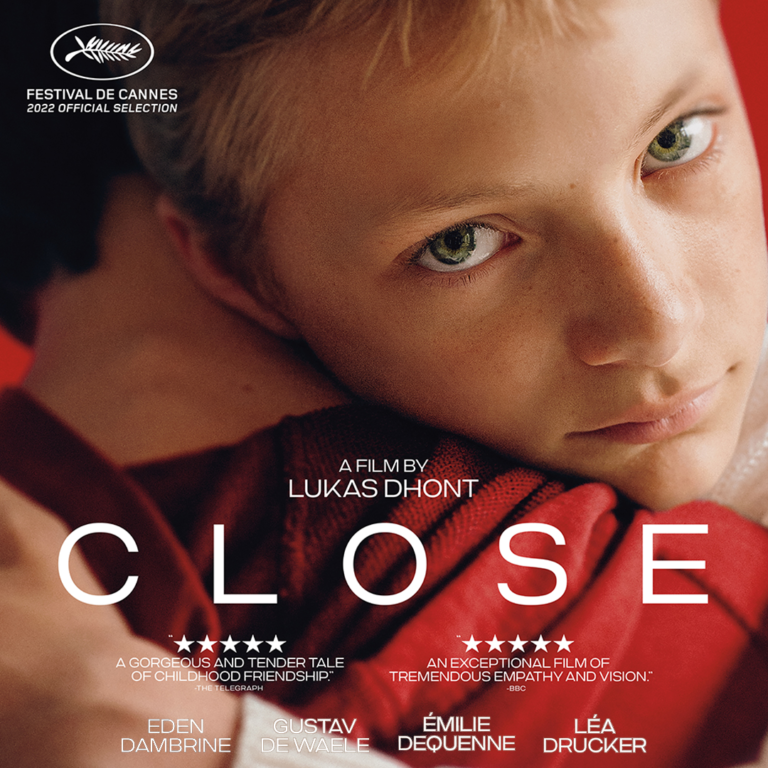Close – Snapshot
Close is a study of two 13-year-old boys who experience a tragedy. While it certainly generates emotions, and is well crafted, it violates principles of Michael’s Movie Moments Manifesto!
Where to Watch:
Stream: Showtime
Rent: Prime/Google ($5); Apple ($6)
Close – The Oscar Buzz
Oscar Nominations:
International Feature Film (Belgium)
Close received a single nomination for International Feature Film, putting it in our “special interest” list. (All Quiet on the Western Front from Germany won the Oscar).
Close – The Movie’s Family Tree
The Following Movies Share Talent with This One (and if you like these films, you might like this one):
Girl (18): Director/Co-Writer (Dhont); Co-Writer (Tijssens); Composer (Hadjadj); Cinematographer (van dan Eeden); Editor (Dessauvage); Makeup (Beckmann);
Close is the second feature film from filmmaker Lukas Dhont. Born in 1991 in Ghent, Belgium, Dhont’s first film was the 2018 feature Girl, a much awarded film about a trans girl pursuing a career in ballet. As you can see from the list above, Dhont used many of the same crew members in both films. Close is, reportedly, based on Dhont’s own life experiences.
This is the feature film debut of both of the Belgian-born actors playing the thirteen-year old boys, Leo and Remi. Dhont found 13-year-old Eden Dambrine (Leo) on a train ride as he listened in on his conversation in the seat ahead of him. Remi is portrayed by 17 year-old Gustavus De Waele.
Close – What Others Think
Close placed just a point or two behind Argentina, 1985, The Quiet Girl and All Quiet on the Western Front in audience ratings, but that was enough to rank it fourth in the International Feature Set. (Compared with all 39 of our films, it ties with Glass Onion and The Batman, about in the middle of the pack.). In short, audience reaction is kind of unexceptional, but not bad!
Critics rated this film similarly. Their ratings put Close at fourth among all International Films (only above All Quiet on the Western Front!), and about in the middle of all thirty-nine of our films. Some of the critical comments are pretty scathing. Ben Kenigsberg (RogerEbert) commented that the extremely close bond between the two main characters suggests something bad is going to happen, “but there’s no depth to the film’s treatment of the fallout, only contrived plot situations and a lot of shameless manipulation designed to maximize tears.” And later “This is a shallow, calculating film masquerading as a sensitive one.” Another RogerEbert critic, Matt Zoller Seitz, extolled the craftsmanship, but “…the more distance I got from it, the more I resented how carelessly it handles emotionally explosive material of a type that has traumatized so many real-life families…”. (My wife, who has experienced similar events, would agree!) He concluded “As focused and controlled as every scene in Close is, it feels, in a way, calculated and almost cruel.” (Ouch!)
Close – Special Mention
Michael’s Movie Moments Manifesto – Close is almost as good at evoking feelings as The Quiet Girl, the film I reviewed last week. And in last week’s review I wrote “So judge a film not by how good it makes you feel, but by how much it makes you feel!”. If that is the criteria for a “good” movie then both of these films have to be ranked high because they both do move you. The emotions are different, and the feelings come from different sources, but I’m pretty sure that both of them will require tissues.
But, I realized after watching these two films back-to-back, that not all tears are equal! And I realized that my stated criteria for a “good” movie is deficient. After giving considerable thought to that problem over the last week, I’d like to propose a more refined criteria for a good film. So here are my current thoughts.
- The stronger the emotions evoked, the better the film is. That’s pretty much what I said last week and it certainly applies to both Close and The Quiet Girl.
- The emotions evoked in the viewer, need to align with those of the filmmaker(s). If the filmmaker had intended a comedy and instead, the viewer felt anger or fear, then we can’t say the movie was a success. A filmmaker fails if he/she doesn’t make the point they intended to make – that’s kind of a basic principle of communication and a movie is communication between the filmmaker and the viewer. Evaluating filmmaker intent is always difficult, but that is one of the reasons I explore a film’s history and the biographies of the people who made it. Notice, though, that I didn’t say the viewer’s and filmmaker’s emotions need to be identical – but they need to be consistent. In The Quiet Girl, there seems to me, to be little doubt about what the director intended. In Close, I think the motivations are less clear.
- The communication must be well crafted. That means pretty much what it sounds like – all the details of making a movie must be done well. The acting, costumes, makeup, sets, sound, music, visual effects, editing, cinematography all must be done with skill. Part of evaluating this criteria involves assessing the backgrounds of all the various crew members and seeing how they have been recognized for their efforts, but it also means paying attention to all the little visual and aural cues the filmmakers make a part of their art. Both Close and The Quiet Girl were well crafted. The cinematography in both films was exquisite and the acting, from such young people was astounding.
- The film must have integrity! Probably the most difficult one to evaluate, but, I would argue, the most important. The film, from beginning to end, must never insult the viewer, and must, in fact, place the viewer’s perspective as more important than the filmmaker’s. The movie must be guided by a consistent set of principles that the director and/or writers are trying to communicate, and they must never lose sight of what that message is. All aspects of the film must work towards the goal of communicating that message. The Quiet Girl has integrity. Babylon’s first hour had integrity, but then it lost it into an incoherent mess of a statement designed, ultimately, to more shock the viewer than elevate him. And where is the integrity of Close? Read on
Close – Michael’s Moments
Close has been criticized by more than one person as manipulative and, I would suggest, that means it doesn’t meet the Integrity standard. Yes, the craftsmanship is all there, especially in the facial closeups on the actors. And nobody can find fault with the two teenage boys playing the main characters. There is no question that it evokes emotions as the set of crumpled tissues between Joan and I verifies. But I do not have a good feeling about just what the young filmmaker Dhont was trying to tell us and, because the intense feelings are jumbled, he doesn’t tell a full, complete, and consistent story.
It is next to impossible to discuss this film without introducing spoilers (something noted by other reviewers.). Let’s say that the movie starts with a pretty intense relationship between two 13-year old boys. There are suggestions of other things going on, but they are never clearly communicated and serve more as background noise. Then, as happens with teenage boys, their circumstances change, feelings and expectations change, and the nature of their relationship changes. (Parts of Close reminded me of the changing relationship between the two men in Banshees of Inisherin.) A change in the nature of a teenage relationship is not uncommon. But in this case it results in a major event. So then Close changes gears dramatically and we are now dealing with the consequences of this major event. The same craftsmanship is used in the post-event and pre-event parts of the film, but the message seems radically different. (Some, including my wife who has experienced similar events, would argue that Dhont doesn’t quite get it right – close, but no cigar!). And in fact, the film, in the second half, sort of beats you over the head, multiple times and in long scenes, trying to communicate the same feelings over and over (this is the tear jerker part).
Meanwhile, what happened to one of the major themes in the first 40 minutes of the movie? The whole idea just sort of disappears, and yet it seemed like a major element. This film feels like two movies somehow fused together, because the first part and the last part don’t explore the same message.
In short, the film lacks integrity. I have no doubt that Dhont experienced something similar to what is portrayed in this film. And, I suspect, he wanted to use this film as a way to explore his own feelings, and it may have accomplished that – for him. But he failed in providing his message with Integrity – he either didn’t completely resolve his own understanding of his situation, or he callously decided to leave his audience in the same confused, unstable, and completely unresolved state that he was in before, and that is disrespectful to us all. Some terrific acting and cinematography, but a muddled message, and that dooms this film. (2.5*)


